

|
       | 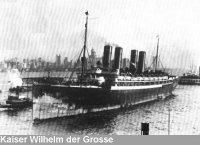 In the late decades of the nineteenth century, Britain ruled the oceans. Rapid technological improvements in shipbuilding techniques, machinery and design, had ensured England pre-eminence on the high-seas for over a century. But during the early years of the twentieth century, two events would shake the British publicís faith in their superiority.
The new German nation had constructed a series of ships designed to wrestle profits and the prestige of holding the Blue Riband for the fastest ship across the Atlantic, away from British hands. The North German-Lloyd company, founded in 1857, won the Blue Riband from Britain in 1897 with their brilliant new flagship, Kaiser Wilhelm der Grosse. She was not only faster than the leading British ships, but larger and more luxurious than all that had come before her. Moreover, she was only the first in a series of lager and faster ships planned by the company. In 1900, Britain would again be upstaged when another German shipping line, Hamburg-Amerika, established in 1847, set a new Atlantic speed record with their new 16, 500 ton Deutschland. In the late decades of the nineteenth century, Britain ruled the oceans. Rapid technological improvements in shipbuilding techniques, machinery and design, had ensured England pre-eminence on the high-seas for over a century. But during the early years of the twentieth century, two events would shake the British publicís faith in their superiority.
The new German nation had constructed a series of ships designed to wrestle profits and the prestige of holding the Blue Riband for the fastest ship across the Atlantic, away from British hands. The North German-Lloyd company, founded in 1857, won the Blue Riband from Britain in 1897 with their brilliant new flagship, Kaiser Wilhelm der Grosse. She was not only faster than the leading British ships, but larger and more luxurious than all that had come before her. Moreover, she was only the first in a series of lager and faster ships planned by the company. In 1900, Britain would again be upstaged when another German shipping line, Hamburg-Amerika, established in 1847, set a new Atlantic speed record with their new 16, 500 ton Deutschland.
 On the other side of the Atlantic, more sinister plans were taking shape. Railroad magnate and financier John Pierpont Morgan in 1901, would form the International Mercantile Marine, and proceeded to take-over British companies, such as the White Star and Red Star Line. It was Morganís intention to monopolise the Atlantic liner trade. Included in this was an attempt to take-over the prominent British owned company of Cunard. English politicians became concerned on hearing the news of the rapid take-overs. In case of war, Britain needed its fleet of merchant ships for war duties and it was uncertain if the now American owned White Star ships, could be commandeered.
Cunardís chairman, Lord Inverclyde, was also concerned. He would however, skilfully use his political influence and take advantage of patriotic sentiment to secure a business coup for his company. He would secure an extremely low-interest twenty-year loan of £2,600,000, for the building of two of the fastest and largest ships the world had yet seen. In return, Cunard agreed to remain in British hands and the ships were to be designed for use in war. Their decks would feature reinforced emplacements for future guns and their coal bunkers would run along the sides of the hull, to help protect their boilers from shell fire. On the other side of the Atlantic, more sinister plans were taking shape. Railroad magnate and financier John Pierpont Morgan in 1901, would form the International Mercantile Marine, and proceeded to take-over British companies, such as the White Star and Red Star Line. It was Morganís intention to monopolise the Atlantic liner trade. Included in this was an attempt to take-over the prominent British owned company of Cunard. English politicians became concerned on hearing the news of the rapid take-overs. In case of war, Britain needed its fleet of merchant ships for war duties and it was uncertain if the now American owned White Star ships, could be commandeered.
Cunardís chairman, Lord Inverclyde, was also concerned. He would however, skilfully use his political influence and take advantage of patriotic sentiment to secure a business coup for his company. He would secure an extremely low-interest twenty-year loan of £2,600,000, for the building of two of the fastest and largest ships the world had yet seen. In return, Cunard agreed to remain in British hands and the ships were to be designed for use in war. Their decks would feature reinforced emplacements for future guns and their coal bunkers would run along the sides of the hull, to help protect their boilers from shell fire.
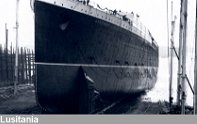 The Tyneside shipbuilding firm of Swan, Hunter and Wigham Richardson were contracted to build the Mauretania. While simultaneously, the Scottish firm of John Brown and Co., of Clydebank, won the contract for the future Lusitania. Construction didnít commence until 1904, Cunard encouraging the different shipbuilding companies, to experiment with the basic design of the ships for best results. The Mauretania would be slightly larger and longer at; 790ft and 31,983 tons, to Lusitaniaís 785ft and 31,550 tons. Although externally the sister ships closely resembled each other, small differences in deck accoutrements, such as the Lusitaniaís canister hinge-topped ventilators, contributed in giving the ship cleaner and more uncluttered lines, than the Mauretaniaís traditional cowl vents.
More substantially, the ships would feature slightly different engine room machinery and different propellers, the Lusitiania sported less efficient three-bladed propellers, while the Mauretania had the more effective four-bladed props. The Lusitania was to be the first to be launched by Lady Inverclyde in June of 1906 and was fitted out by the summer of 1907. On her secret builders trials, a problem immediately presented itself. While her revolutionary turbine powered engines performed well above expectation, it reduced the Lusitaniaís stern to a hell of vibration, making some public areas in second class uninhabitable. The Lusitania was returned to her builders for extensive interior modifications, including elements such as subdividing rooms by adding arches and columns, to help stiffen the stern. This was effective to some extent, but the problem would remain for all of her short career. The Mauretania would also have a problem with vibration in her bow, but it was never as severe as the Lusitania. (Ballard, Dunmore, 1995:22). The Tyneside shipbuilding firm of Swan, Hunter and Wigham Richardson were contracted to build the Mauretania. While simultaneously, the Scottish firm of John Brown and Co., of Clydebank, won the contract for the future Lusitania. Construction didnít commence until 1904, Cunard encouraging the different shipbuilding companies, to experiment with the basic design of the ships for best results. The Mauretania would be slightly larger and longer at; 790ft and 31,983 tons, to Lusitaniaís 785ft and 31,550 tons. Although externally the sister ships closely resembled each other, small differences in deck accoutrements, such as the Lusitaniaís canister hinge-topped ventilators, contributed in giving the ship cleaner and more uncluttered lines, than the Mauretaniaís traditional cowl vents.
More substantially, the ships would feature slightly different engine room machinery and different propellers, the Lusitiania sported less efficient three-bladed propellers, while the Mauretania had the more effective four-bladed props. The Lusitania was to be the first to be launched by Lady Inverclyde in June of 1906 and was fitted out by the summer of 1907. On her secret builders trials, a problem immediately presented itself. While her revolutionary turbine powered engines performed well above expectation, it reduced the Lusitaniaís stern to a hell of vibration, making some public areas in second class uninhabitable. The Lusitania was returned to her builders for extensive interior modifications, including elements such as subdividing rooms by adding arches and columns, to help stiffen the stern. This was effective to some extent, but the problem would remain for all of her short career. The Mauretania would also have a problem with vibration in her bow, but it was never as severe as the Lusitania. (Ballard, Dunmore, 1995:22).
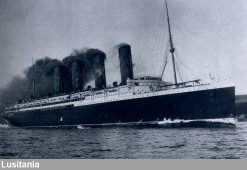 Due to unfavourable weather conditions, the Lusitania would take several voyages, before she wrested the Blue Riband from her German rivals. She would cross the Atlantic in under five days, the first ship ever to do so. The Mauretania made her maiden voyage on November 16, 1907 and immediately proved herself a thoroughbred. It would however, take a few voyages for her to snatch the Blue Riband from her sister, shaving twenty-four minutes off the Lusitaniaís eastbound record. Both ships would continue to beat each others records until the Mauretania, turned in her best pre-war performance of 26.25 knots, Mauretania would hold the record for over twenty years.
These impressive ships were also more luxuriously appointed than any before them. Unlike the White Star Lines vesselís, the interiors of the Lusitania and the Mauretania, featured strikingly different interior decor. Up until the war the Lusitania was always the more popular ship, some having said this was due to her more airy interior decor, relying heavily on plaster work and gilt. While the Mauretaniaís decor featured traditional heavy wood panelling. The ships made huge profits for Cunard and were extremely reliable, the Lusitania made a record sixteen round-trip voyages, and remarkably the Mauretania was in continuous service without a major reconditioning from 1909 - 1911. Due to unfavourable weather conditions, the Lusitania would take several voyages, before she wrested the Blue Riband from her German rivals. She would cross the Atlantic in under five days, the first ship ever to do so. The Mauretania made her maiden voyage on November 16, 1907 and immediately proved herself a thoroughbred. It would however, take a few voyages for her to snatch the Blue Riband from her sister, shaving twenty-four minutes off the Lusitaniaís eastbound record. Both ships would continue to beat each others records until the Mauretania, turned in her best pre-war performance of 26.25 knots, Mauretania would hold the record for over twenty years.
These impressive ships were also more luxuriously appointed than any before them. Unlike the White Star Lines vesselís, the interiors of the Lusitania and the Mauretania, featured strikingly different interior decor. Up until the war the Lusitania was always the more popular ship, some having said this was due to her more airy interior decor, relying heavily on plaster work and gilt. While the Mauretaniaís decor featured traditional heavy wood panelling. The ships made huge profits for Cunard and were extremely reliable, the Lusitania made a record sixteen round-trip voyages, and remarkably the Mauretania was in continuous service without a major reconditioning from 1909 - 1911.
 As popular as these two ships were, the Cunard line needed another big ship to guarantee weekly sailings from either side of the Atlantic. The venerable Aquitania entered service in June of 1914, only two months before the outbreak of war. At 45,600 tons the Aquitania was larger than her older running mates, but unlike the Mauretania, she was never intended to be a speed queen. She was following in the wake of the latest Atlantic trend for slower, more stable and exceedingly luxurious vessels, such as White Starís Olympic and the Hamburg-Amerika lineís Imperator. The Aquitania would provide Cunard with over 35 years of reliable service and would serve its country on both world wars.
The outbreak of war would cut short Cunardís dream of a weekly service, the Aquitania and the Mauretania were both requisitioned for war duties, while the Lusitania was to remain in her civilian role on the Atlantic run. Very quickly, the Mauretania and the Aquitania would prove themselves impractical as auxiliary cruiserís due to their unarmoured hulls and prodigious appetites for coal, so they were dispatched to serve as troopers and hospital ships. On May the 7th, 1915, a torpedo from a German submarine struck the Lusitania, causing a massive sympathetic explosion on her starboard side. The ship sank in less than twenty minutes, before many of the lifeboats could be successfully launched, taking the lives of over 1,195 people. As popular as these two ships were, the Cunard line needed another big ship to guarantee weekly sailings from either side of the Atlantic. The venerable Aquitania entered service in June of 1914, only two months before the outbreak of war. At 45,600 tons the Aquitania was larger than her older running mates, but unlike the Mauretania, she was never intended to be a speed queen. She was following in the wake of the latest Atlantic trend for slower, more stable and exceedingly luxurious vessels, such as White Starís Olympic and the Hamburg-Amerika lineís Imperator. The Aquitania would provide Cunard with over 35 years of reliable service and would serve its country on both world wars.
The outbreak of war would cut short Cunardís dream of a weekly service, the Aquitania and the Mauretania were both requisitioned for war duties, while the Lusitania was to remain in her civilian role on the Atlantic run. Very quickly, the Mauretania and the Aquitania would prove themselves impractical as auxiliary cruiserís due to their unarmoured hulls and prodigious appetites for coal, so they were dispatched to serve as troopers and hospital ships. On May the 7th, 1915, a torpedo from a German submarine struck the Lusitania, causing a massive sympathetic explosion on her starboard side. The ship sank in less than twenty minutes, before many of the lifeboats could be successfully launched, taking the lives of over 1,195 people.
 After the war, Cunard received the ex-German liner Imperator as war reparations and renamed her the Berengaria. For the next fifteen years Cunard would operate the "big three" liners, the Mauretaina, Aquitania and the Berengaria and rebuild her fleet with more modest sized vessels. During the early thirties Cunard plans were well advanced for retiring the Mauretania, Berengaria and Aquitania and replacing them with two enormous high speed liners which could satisfy a two ship weekly service. Britain hadnít yet recovered from the economic depression, and shipping lines were particularly hard hit, due to the United States closing the curtain on unrestricted immigration. Cunard withdrew the Mauretania from service in September of 1934 and for almost a year she rested quietly at dockside in Southampton, and then sold for scrap in 1935. The White Star Line, once again a British company, was planning a 50,000 ton diesel motor vessel. The keel was laid for the new White Star Oceanic, but financial and labour problems stopped its completion. Cunard began construction of hull 534, The Queen Mary in 1932, but financial problems would cause work on the project to stop, until it was resumed in 1934 after the British government forced the merger of White Star and Cunard.
The White Star Line was the only serious British competitor to Cunard. White Star had enjoyed healthy profits in the late decades of the nineteenth century with their large ships, Celtic, Majestic and Oceanic. As we saw above, John Pierpont Morgan the Railroad magnate and financier, took control of the White Star line in 1901. With the success of Cunardís Mauretania and Lusitania, Bruce Ismay, the lines managing director and Lord William James Pirrie, of the shipbuilders Harland and Wolff conceived a bold plan to build three huge vessels to rival Cunard, not with speed but with size, comfort and luxury. After the war, Cunard received the ex-German liner Imperator as war reparations and renamed her the Berengaria. For the next fifteen years Cunard would operate the "big three" liners, the Mauretaina, Aquitania and the Berengaria and rebuild her fleet with more modest sized vessels. During the early thirties Cunard plans were well advanced for retiring the Mauretania, Berengaria and Aquitania and replacing them with two enormous high speed liners which could satisfy a two ship weekly service. Britain hadnít yet recovered from the economic depression, and shipping lines were particularly hard hit, due to the United States closing the curtain on unrestricted immigration. Cunard withdrew the Mauretania from service in September of 1934 and for almost a year she rested quietly at dockside in Southampton, and then sold for scrap in 1935. The White Star Line, once again a British company, was planning a 50,000 ton diesel motor vessel. The keel was laid for the new White Star Oceanic, but financial and labour problems stopped its completion. Cunard began construction of hull 534, The Queen Mary in 1932, but financial problems would cause work on the project to stop, until it was resumed in 1934 after the British government forced the merger of White Star and Cunard.
The White Star Line was the only serious British competitor to Cunard. White Star had enjoyed healthy profits in the late decades of the nineteenth century with their large ships, Celtic, Majestic and Oceanic. As we saw above, John Pierpont Morgan the Railroad magnate and financier, took control of the White Star line in 1901. With the success of Cunardís Mauretania and Lusitania, Bruce Ismay, the lines managing director and Lord William James Pirrie, of the shipbuilders Harland and Wolff conceived a bold plan to build three huge vessels to rival Cunard, not with speed but with size, comfort and luxury. 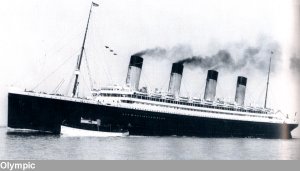 White Star only had the finances to construct two of the vessels, and for the first time they would be constructed side-by-side in specially built gantries. The Olympic was the first completed and launched on October 20, 1910. The 45,324 ton Olympic made her first voyage on June 14, 1911, only fifteen days earlier the Titanic had been launched to much fanfare. In September, 1911, the Olympic would suffer a collision with the navel ship Hawke, causing serious damage and holding up completion of the Titanic, as parts were cannibalised to repair the almost identical Olympic.
The Titanic would begin her maiden voyage on April the 10th, 1912, it would become the most disastrous and well documented voyages in history. There is a wealth of information regarding the Titanic, so I will adhere to the plain facts. In the late hours of April the 14th, 1912, the Titanic stuck an iceberg, causing some of her hull plates to separate as the rivets were popped. Water started pouring into six of her "watertight" compartments, the Titanic had been designed to float with four compartments flooded, not six. In a little over two hours the ship would sink on its beam end, breaking in two, between the third and fourth funnels. Over 1,500 people lost their lives, due to a severe lack of lifeboats. The positive legacy of the Titanic disaster was the improvement of safety at sea, laws were amended to demand a lifeboat place for all souls aboard, regardless of class. (Marriot, McCulskie, Sharpe, 1998:32-98). White Star only had the finances to construct two of the vessels, and for the first time they would be constructed side-by-side in specially built gantries. The Olympic was the first completed and launched on October 20, 1910. The 45,324 ton Olympic made her first voyage on June 14, 1911, only fifteen days earlier the Titanic had been launched to much fanfare. In September, 1911, the Olympic would suffer a collision with the navel ship Hawke, causing serious damage and holding up completion of the Titanic, as parts were cannibalised to repair the almost identical Olympic.
The Titanic would begin her maiden voyage on April the 10th, 1912, it would become the most disastrous and well documented voyages in history. There is a wealth of information regarding the Titanic, so I will adhere to the plain facts. In the late hours of April the 14th, 1912, the Titanic stuck an iceberg, causing some of her hull plates to separate as the rivets were popped. Water started pouring into six of her "watertight" compartments, the Titanic had been designed to float with four compartments flooded, not six. In a little over two hours the ship would sink on its beam end, breaking in two, between the third and fourth funnels. Over 1,500 people lost their lives, due to a severe lack of lifeboats. The positive legacy of the Titanic disaster was the improvement of safety at sea, laws were amended to demand a lifeboat place for all souls aboard, regardless of class. (Marriot, McCulskie, Sharpe, 1998:32-98).
 The White Star Line would never be the same again. The Olympic would undergo a costly refit, to give her new "double skin" longitudinal bulkheads, such as on Cunard vessels and the fitting of more lifeboats. The third ship in the series the Britannic, was the largest of the three sisters. She was launched on February 26th, 1914, but would never see civilian service. She was hurriedly converted to become a hospital ship and could accommodate approximately 3,300 casualties and a medical staff and crew of around 1,000. The Britannicís main external feature that distinguished her from her older siblings, were her huge gantry lifeboat davits, capable of launching more than one boat a time. On the 23rd of December, 1915, the Britannic sailed from Liverpool on her maiden voyage heading for the Mediterranean where she would be employed on the so-called Dardenells service alongside her sister ship Olympic, who would distinguish herself in war by ramming and sinking a German submarine. She would complete several voyages in this role until the morning of Tuesday, 21st of November, 1916, when she struck a mine two miles from the Greek island of Kea. Captain Bartlett, at first thought the ship was only slightly damaged and tried to beach her, but he soon discovered that the Britannic was mortally wounded and gave the order to abandon ship. The ship sank in less than an hour with the loss of 74 lives. After the war the White Star Line would receive the uncompleted ex-German liner Bismarck, and would give her one of the traditional names of her fleet, Majestic. The White Star Line would never be the same again. The Olympic would undergo a costly refit, to give her new "double skin" longitudinal bulkheads, such as on Cunard vessels and the fitting of more lifeboats. The third ship in the series the Britannic, was the largest of the three sisters. She was launched on February 26th, 1914, but would never see civilian service. She was hurriedly converted to become a hospital ship and could accommodate approximately 3,300 casualties and a medical staff and crew of around 1,000. The Britannicís main external feature that distinguished her from her older siblings, were her huge gantry lifeboat davits, capable of launching more than one boat a time. On the 23rd of December, 1915, the Britannic sailed from Liverpool on her maiden voyage heading for the Mediterranean where she would be employed on the so-called Dardenells service alongside her sister ship Olympic, who would distinguish herself in war by ramming and sinking a German submarine. She would complete several voyages in this role until the morning of Tuesday, 21st of November, 1916, when she struck a mine two miles from the Greek island of Kea. Captain Bartlett, at first thought the ship was only slightly damaged and tried to beach her, but he soon discovered that the Britannic was mortally wounded and gave the order to abandon ship. The ship sank in less than an hour with the loss of 74 lives. After the war the White Star Line would receive the uncompleted ex-German liner Bismarck, and would give her one of the traditional names of her fleet, Majestic.
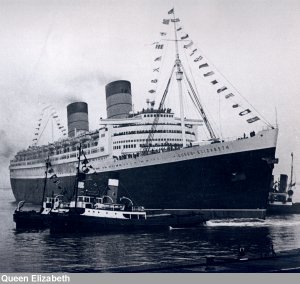 As we have already seen, the White Star line was forced to merge with its rival Cunard in 1934, to provide finance to begin work on the Queen Mary. Queen Mary, the wife of George V, christened and launched her on September, 1935. Unlike her most fierce competitor of the era, the chic French line vessel the Normandie, the Queen Mary was a throwback to an earlier era, resembling the Aquitania in appearance, more than the modern German or Italian liners. However, the Queen Mary was a fast ship, snatching the Blue Riband from her French rival in August of 1935. The award would pass from ship to ship until the Mary in August of 1938, crossed the Atlantic in three days, twenty hours and forty minutes, she would hold the record for over twenty years. The outbreak of World War two cut short the careers of these two giant liners, they spent the opening months moored in close proximity at their respective New York piers. In March of 1940 they were joined by the not quite completed Queen Elizabeth, who had completed a top-secret voyage to the United States to prevent her becoming a target for the Germans. Both the Mary and the Elizabeth would be converted to become the most celebrated troop ships of the century, both were converted in Sydney, Australia.
After the war, the Cunard line would find that they had the Atlantic market cornered, the Queen Mary and the Queen Elizabeth were of of the few "superliners", to survive the war, only the ex-German liner Europa, now ceded to the French, was around to provide a worthy rival. During the fifties, the Queen Mary and Queen Elizabeth, would provide the line with record profits and prestige. However, due to the popularity of the airlines, in the 1960ís the ships would become almost ghost ships, and both were retired in the sixties. The Queen Mary lives on to this day, at Long Beach, California, preserved as a floating museum and hotel. Her fleet mate, Queen Elizabeth, was sold to interests in the orient, to become a floating university. Her fitting out was almost complete when on the 9th of January, 1972 fire broke out in her passenger accommodation and spread very quickly. The ship would burn until she capsized under the weight of gallons of water pumped on to her by overzealous firemen. There she languished in the harbour, a gruesome tourist attraction and was featured in a James Bond film, before finally being scrapped. In 1969, Cunardís current flagship, the Queen Elizabeth the Second, entered service, and remains popular to this day, with plans to pair her up with a new 100,000 ton Queen Mary. ...(bibliography). (british liners gallery)... As we have already seen, the White Star line was forced to merge with its rival Cunard in 1934, to provide finance to begin work on the Queen Mary. Queen Mary, the wife of George V, christened and launched her on September, 1935. Unlike her most fierce competitor of the era, the chic French line vessel the Normandie, the Queen Mary was a throwback to an earlier era, resembling the Aquitania in appearance, more than the modern German or Italian liners. However, the Queen Mary was a fast ship, snatching the Blue Riband from her French rival in August of 1935. The award would pass from ship to ship until the Mary in August of 1938, crossed the Atlantic in three days, twenty hours and forty minutes, she would hold the record for over twenty years. The outbreak of World War two cut short the careers of these two giant liners, they spent the opening months moored in close proximity at their respective New York piers. In March of 1940 they were joined by the not quite completed Queen Elizabeth, who had completed a top-secret voyage to the United States to prevent her becoming a target for the Germans. Both the Mary and the Elizabeth would be converted to become the most celebrated troop ships of the century, both were converted in Sydney, Australia.
After the war, the Cunard line would find that they had the Atlantic market cornered, the Queen Mary and the Queen Elizabeth were of of the few "superliners", to survive the war, only the ex-German liner Europa, now ceded to the French, was around to provide a worthy rival. During the fifties, the Queen Mary and Queen Elizabeth, would provide the line with record profits and prestige. However, due to the popularity of the airlines, in the 1960ís the ships would become almost ghost ships, and both were retired in the sixties. The Queen Mary lives on to this day, at Long Beach, California, preserved as a floating museum and hotel. Her fleet mate, Queen Elizabeth, was sold to interests in the orient, to become a floating university. Her fitting out was almost complete when on the 9th of January, 1972 fire broke out in her passenger accommodation and spread very quickly. The ship would burn until she capsized under the weight of gallons of water pumped on to her by overzealous firemen. There she languished in the harbour, a gruesome tourist attraction and was featured in a James Bond film, before finally being scrapped. In 1969, Cunardís current flagship, the Queen Elizabeth the Second, entered service, and remains popular to this day, with plans to pair her up with a new 100,000 ton Queen Mary. ...(bibliography). (british liners gallery)...FastCounter by bCentral People have visited this page since; 11/6/96 | Ocean Liners | Links | View Guestbook | Sign Guestbook | E-mail | |